Soft and chewy gluten-free oatmeal cookies with molasses and warm spices. Delicious as-is or topped with icing. Easily make nut-free or dairy-free, or add in raisins or chocolate chips.
This post is brought to you by Bob’s Red Mill, a long-term partner of Snixy Kitchen
When given the choice between a slice of leftover pie and one of these iced gluten-free oatmeal cookies, both of my children chose the cookie. With their craggy snowy mountain tops of icing, these cookies have the allure factor, even to my kids who don't have nostalgia for an old-fashioned lunchbox cookie.
These cookies are scoring me lots of mom points with my kids. The other day, Zoella (5) told me I was one of her favorite moms. Yes, ONE OF. Apparently she "has a lot of mom friends." And the competition is stiff. So with that, I went back to the kitchen to bake more bribes.
We make a lot of oatmeal cookies in our house, but somehow I've yet to share my classic gluten-free oatmeal cookie recipe. The recipe that's as versatile as a little black dress. Enjoy as-is or topped simply with flaky salt. Dress them up with a wisp of icing or mix in dried fruit, nuts, or chocolate chips. Or divide up the dough and do a little of each.
These gluten-free spiced oatmeal cookies are my sixth recipe in a year-long partnership with Bob’s Red Mill. Here’s a list of all the recipes I’ve made in partnership with Bob’s Red Mill over the years.
What kind of Oats for Gluten-Free Oatmeal Cookies?
The perfect oatmeal cookie depends on the oats. For these cookies, you need old-fashioned rolled oats, not instant oats. And to ensure there's no cross-contamination, I use Bob's Red Mill gluten-free old-fashioned rolled oats, which are made in a dedicated facility. Their oats are high quality and consistent in texture and flavor.
I do not recommend substituting quick-cooking oats or instant oats, as they are rolled thinner and thus soak up moisture quicker, which can leave your cookie tasting dry without the proper texture.
Pulsing the oats for the softer texture
To get the perfect soft, but chewy texture for iced gluten-free cookies, pulse the old-fashioned rolled oats in a food processor or blender until you've got a mix of some finely ground oat flour and some whole oats (see picture above). Pulsing creates a softer and fluffier cookie than using whole oats and leaves a smoother texture on top that's ideal for the crackly icing.
For a classically chewy oatmeal cookie with crisp edges and no icing, you can skip the pulsing and add a minute to the baking time. Below is a texture comparison between cookies baked with whole rolled oats versus with pulsed rolled oats.


What Flour for Chewy Gluten-Free Cookies
While I'm partial to the slight nuttiness almond flour adds to cookies, I also developed a nut-free version using oat flour. Unless tasting side-by-side, they're almost indistinguishable. Either way, you'll love these cookies!
Both versions pair either super-fine blanched almond flour or gluten-free oat flour with tapioca flour and sweet rice flour to create a cookie that bakes up soft, chewy, and moist with crisp edges.
- Tapioca flour: Tapioca flour offers chewiness and adds to the fluffiness and crisp edges of the cookies. It's what keeps the cookies from being too dense.
- Sub in by weight: While I haven't tested it, I would recommend substituting by weight with arrowroot starch.
- Sweet Rice Flour: sweet rice flour is distinctively different than white rice or brown rice flour. Sweet rice flour is the same flour used to make mochi, and as such, it also contributes to the chewiness of the cookie center.
- Sub in by weight: additional tapioca flour. The results will be a bit less chewy, but still delicious.
I recommend only Bob's Red Mill brand flours, which are consistent in quality, with a fine grind that is never gritty. Subbing in a different brand of flour is the most common reason a recipe doesn't turn out as expected. Consistent flour texture is especially important for cookies that should be crisp, moist, soft, and chewy all at once.
Almond Flour Variation
The subtle sweet nuttiness of almond flour is the most neutral gluten-free flour to capture that classic cookie flavor and texture. Almond flour does not make the baked cookie taste like almonds but adds subtle warm and cozy flavor notes that pair beautifully with oatmeal and spices. Because of the higher fat and moisture content in almond flour, you'll need more flour than in the oat flour version, which creates a couple of extra bonus cookies.
- Substitution: If you cannot tolerate nuts, use the oat flour version below.
Nut-Free Oat Flour Variation
If using the oat flour variation, be sure to look for Bob's Red Mill gluten-free oat flour if you want to be sure your cookies are 100% gluten-free.
When used alone, oat flour is a soft and light flour that's almost cakey. When combined with tapioca flour and sweet rice flour, it acts as the structure of the cookie, imparting a warm wholesome flavor, that, well, tastes just as an oatmeal cookie should.
- Option: grind up gluten-free old-fashioned rolled oats in a food processor or blender, then sift out any big pieces. Make sure to measure this by weight as homemade gluten-free oat flour is less finely ground so the volume per weight will be different.
- Sub in by weight: Teff Flour or Bob's Red Mill Gluten Free 1-to-1 Baking Flour.
How to Make chewy and soft gluten-free oatmeal cookies
Here are my steps and tips for making the best soft and chewy gluten-free oatmeal cookies.
- Preheat the oven to 350°F.
- Pulse oats. For iced gluten-free oatmeal cookies or if you prefer a thicker softer cookie, pulse the oats 10-15 times in a food processor or blender before using. Set aside.
- Sift dry ingredients.
- Cream butter and sugars. The butter should be softened almost to room temperature, but not melted. I recommend organic light brown sugar as it is more moist with a more assertive molasses flavor than conventional and thus creates a chewier more flavorful cookie.
- Mix in egg, molasses, and vanilla. Adding molasses increases the brown sugar notes and helps keep the cookies soft and chewy.
- Add dry ingredients. Slowly add the dry ingredients until combined.
- Mix in pulsed oats and any add-ins. Mix just until thoroughly combined.
- Roll and chill cookie dough. Use a cookie scoop to roll the cookie dough into even balls and chill.
- Bake. Bake 11-13 minutes until the edges are just set, but the center still looks underbaked. Take care not to overbake, as they'll continue cooking on the baking sheet and the oats will soak up more moisture as they cool.
- Cool. Let cool on baking sheet for 5 minutes, then transfer to a wire rack to cool completely before icing.
- Prepare icing. Whisk together the icing ingredients into a very thick, smooth icing.
- Dip in icing. Once the cookies have cooled completely, very lightly dip the tops of the cookies in the icing as desired. After an hour or so, the icing will harden so the cookies can be stacked.
Thick v. Thin Oatmeal Cookies
Whether you prefer a thicker cookie or a thinner cookie is a matter of personal preference. I personally prefer these oatmeal cookies thicker, soft, and chewier over thin and crisp. Your preference will determine whether or not you chill the dough.
If you bake the cookies without chilling, cut the bake time down by 1 minute. Your cookies will bake up thinner with crispier edges. Note: if you like them extra thin, try my Gluten-Free Oatmeal Chocolate Chip Cookies.
Chilling, on the other hand, produces a slightly loftier cookie that's soft and chewy with slightly crisp edges.
Iced Oatmeal Cookies
Adding icing to these cookies gives them a nostalgic look and flavor just like mother's. The icing also helps to add and lock in the moisture, keeping the cookies soft and tender for longer.
The key to gluten-free oatmeal cookies with craggy icing is to ensure the icing is super thick. Add just enough milk to create a completely smooth icing that isn't runny. This will keep it from dripping into the nooks or off the edges.
With the thick icing, lightly tap the tops of the completely cooled cookies in the icing a few times until you've got the desired coverage.
Can you make these cookies Dairy-Free?
Looking for gluten-free dairy-free oatmeal cookies? Just sub out the butter for a plant-based stick butter and the milk for your favorite plant-based milk!
Gluten-Free Oatmeal Cookie Recipe Variations
This base gluten-free oatmeal cookie recipe is endlessly customizable. With this beloved classic cookie recipe in hand, you can go wild with add-ins to suit your fancy!
- Raisins or dried cranberries: For gluten-free oatmeal raisin or cranberry cookies, add ½ - ¾ cup raisins or dried cranberries. Use dried fruit that is soft and plump rather than too withered and dry.
- Nuts: Add ½ - ¾ cup chopped walnuts or pecans to the dough. Toast the nuts before adding them to the cookie dough for the best flavor and texture.
- Chocolate chips: Add 4 ounces of chocolate chips or chopped chocolate to the dough. Press a few pieces of chocolate into the top of each cookie dough ball for puddles of chocolate. I also highly recommend this thinner recipe for Gluten-Free Oatmeal Chocolate Chip Cookies.
How to store this gluten-free cookie dough?
If you don't want to bake all the cookies at once, you can bake some now and store the rest for later!
Use a cookie scoop to roll the cookie dough into even balls and chill on a baking sheet in the fridge for an hour or freezer for 15 minutes. Once firm, transfer the cookie dough balls to a gallon freezer bag and store in the fridge for up to 5 days or in the freezer for up to 6 months.
If you've stored the cookie dough in the freezer for longer than 30 minutes, you'll also need 1-2 additional minutes of the baking time. When baking the cookies directly from long freezer storage, they will bake up thicker than pictured here.
Alternatively, let the dough sit at room temperature for 30 minutes before baking if you don't want your cookies to bake up thicker.
How to store gluten-free oatmeal cookies
Store these oatmeal cookies in an airtight container for up to 4 days.
Oatmeal soaks up moisture the longer it sits, which can make oatmeal cookies taste dry and stale quickly. With brown sugar and molasses, these gluten-free oatmeal cookies retain their moisture when stored.
Additionally, the icing continues to soften the cookies over time, adding and trapping in moisture.
Gluten-Free Christmas Cookies
Deliver the most festive gluten-free Christmas cookie platter to your friends and neighbors. Here are a few of my favorite recipes.
- Gluten-Free Sugar Cookies with Icing
- Gluten-Free Coconut Macaroons
- Gluten-Free Thumbprint Cookies
- Gluten-Free Snickerdoodles
- Matcha Macarons
- Chocolate Hazelnut Gluten-Free Slice and Bake Cookies
- Gluten-Free Peanut Butter Cookies
- Gluten-Free Chocolate Cookies
- Gluten-Free Chocolate Pecan Shortbread Cookies
- Homemade Gluten-Free Oreos
- Gluten-Free White Chocolate Matcha Shortbread Cookies
If you're feeling overwhelmed by buying different gluten-free flours, you can also use my recipe filter to sort recipes by gluten-free flour type to use up what you've got.
Recipe

Gluten-Free Oatmeal Cookies
Ingredients
- 165 g (1½ cups) Bob's Red Mill gluten-free old-fashioned rolled oats
- 91 g (¾ cup + 1 tablespoon) Bob's Red Mill super-fine blanched almond flour
- 56 g (½ cup) Bob's Red Mill tapioca flour
- 50 g (¼ cup + 1 tablespoon) Bob's Red Mill sweet rice flour, Also called mochiko, different from "white rice flour" or "brown rice flour"
- ½ teaspoon baking soda
- ½ teaspoon baking powder
- 1 teaspoon ground cinnamon
- ¼ teaspoon ground nutmeg
- ¼ teaspoon kosher salt
- ½ cup unsalted butter, room temperature
- 100 g (½ cup) organic light brown sugar
- 52 g (¼ cup) granulated sugar
- 1 large egg, room temperature
- ½ tablespoon molasses
- 1 teaspoon pure vanilla extract
- Optional: Icing, see below
- 165 g (1½ cups) Bob's Red Mill gluten-free old-fashioned rolled oats
- 81 g (¾ cup) Bob's Red Mill gluten-free oat flour
- 30 g (3 tablespoons) Bob's Red Mill sweet rice flour, Also called mochiko, different from "white rice flour" or "brown rice flour"
- 28 g (¼ cup) Bob's Red Mill tapioca flour
- ½ teaspoon baking soda
- ½ teaspoon baking powder
- 1 teaspoon ground cinnamon
- ¼ teaspoon ground nutmeg
- ¼ teaspoon kosher salt
- ½ cup unsalted butter, room temperature
- 100 g (½ cup) organic light brown sugar
- 52 g (¼ cup) granulated sugar
- 1 large egg, room temperature
- ½ tablespoon molasses
- 1 teaspoon pure vanilla extract
- Optional: Icing, see below
- 1 cup (120 g) powdered sugar, sifted
- ¼ teaspoon pure vanilla extract
- 1-2 tablespoons milk
- Pinch kosher salt
INSTRUCTIONS
- Preheat oven to 350°F and line a large baking sheet with parchment paper.
- If making the iced oatmeal cookies, pulse the rolled oats in the food processor 10-15 times until some of the oats are finely ground and some are just coarsely chopped. This will give the cookie a fluffier texture that is only moderately textured on top, making it ideal for dipping in the icing. If you're not going to ice the cookies, skip this step. Set the oats aside.
- In a medium mixing bowl, sift together the almond or oat flour, tapioca flour, sweet rice flour, baking soda, baking powder, cinnamon, nutmeg, and salt. Set aside.
- In the bowl of a stand mixer fitted with the paddle attachment or a large mixing bowl with a hand mixer, cream the butter and sugars together starting on low speed and increasing to medium-high speed, until light and fluffy, 3-5 minutes. Scrape down the sides and add the egg, molasses, and vanilla extract and beat until just combined, scraping down the sides as needed.
- With the mixer on low speed, slowly add the sifted flours until just combined. Add the rolled oats and beat for a few seconds until evenly distributed.
- Scoop the dough into 1½ tablespoon-sized balls onto a baking sheet (I use the OXO medium cookie scoop and it makes exactly 18-21 cookies, depending on oat v almond variations).
- Bake immediately or for thicker cookies, chill the cookie dough in the fridge for 1 hour or in the freezer for 15 minutes, until firm. Working in batches, place the chilled cookie dough balls 2 inches apart on the parchment-lined baking sheet. Skip chilling and space cookie dough directly on the parchment-lined baking sheet for thinner cookies.
- Bake chilled cookies for 13 minutes or room temperature cookies for 10-12 minutes, until the edges are set, but the center still looks slightly underbaked. If you did not pulse the oats in step 1, add 1 minute to the baking time. Let cool for 5 minutes on the baking sheet before transferring to a cooling rack with a thin spatula to cool completely before icing.
- When the cookies are completely cooled, prepare the icing.
- In a small bowl, mix together the powdered sugar, vanilla, salt, and ½ tablespoon of milk. Add more milk, 1 teaspoon at a time, just until the icing is smooth but very thick. When drizzled back onto itself, the icing should hold its shape for a few seconds before settling back into the bowl. Take a cooled cookie and very lightly dip the top of it in the bowl of icing a few times until it has the desired amount of icing. Imagine gently tapping the cookie on the icing letting any excess drip off before turning it over. This will produce the crackly top. Serve immediately or return to the wire rack to let the icing set for an hour before stacking cookies.



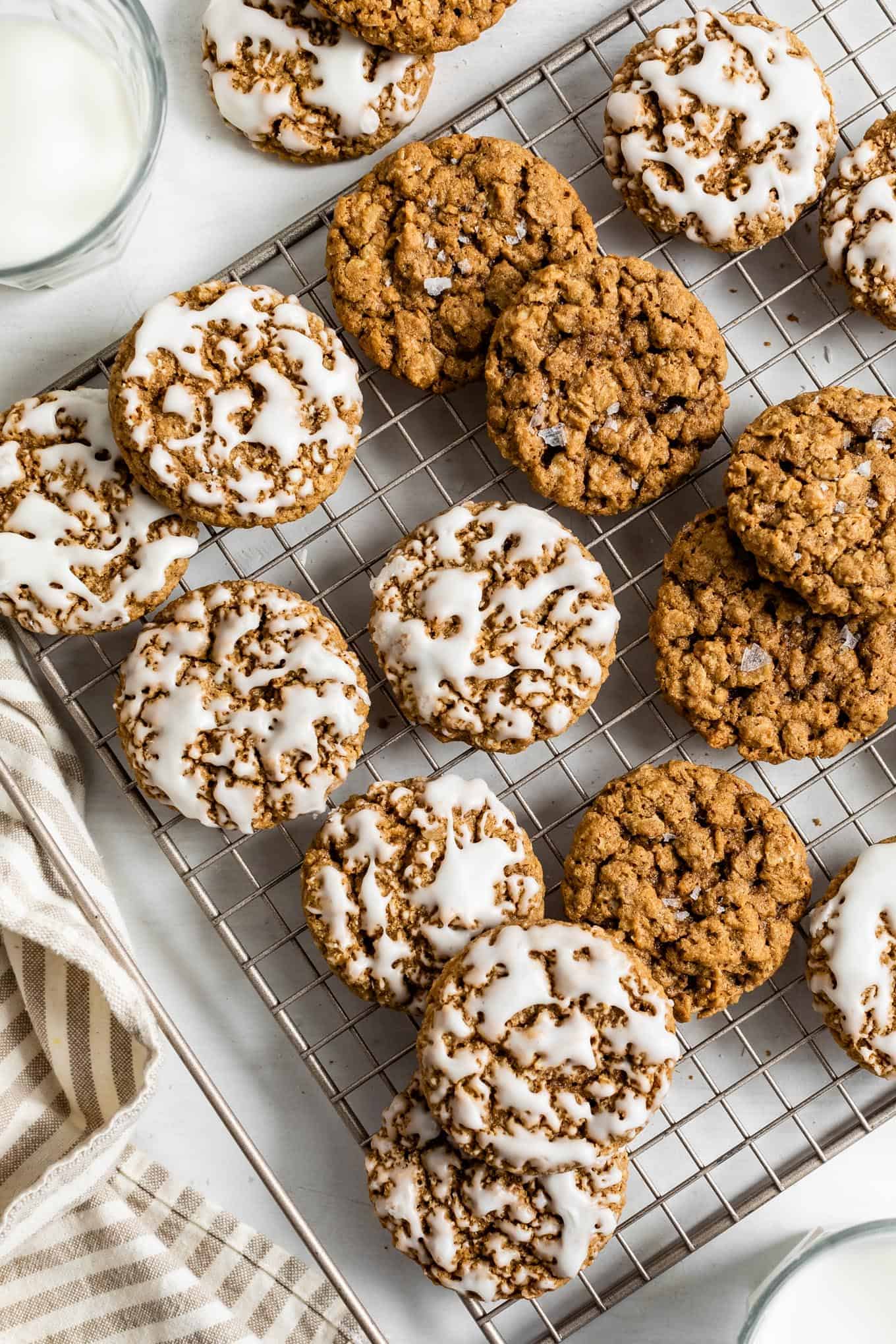
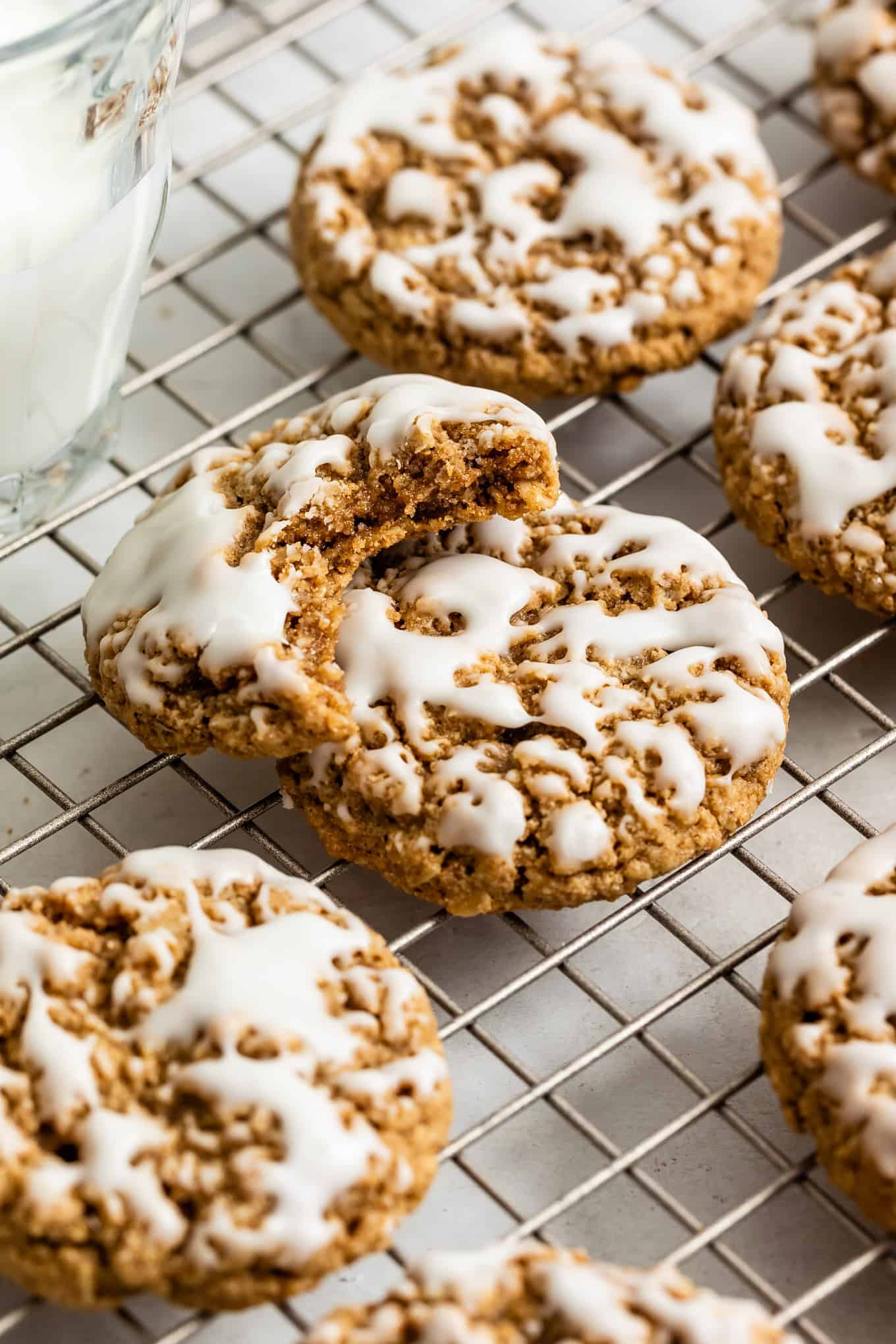

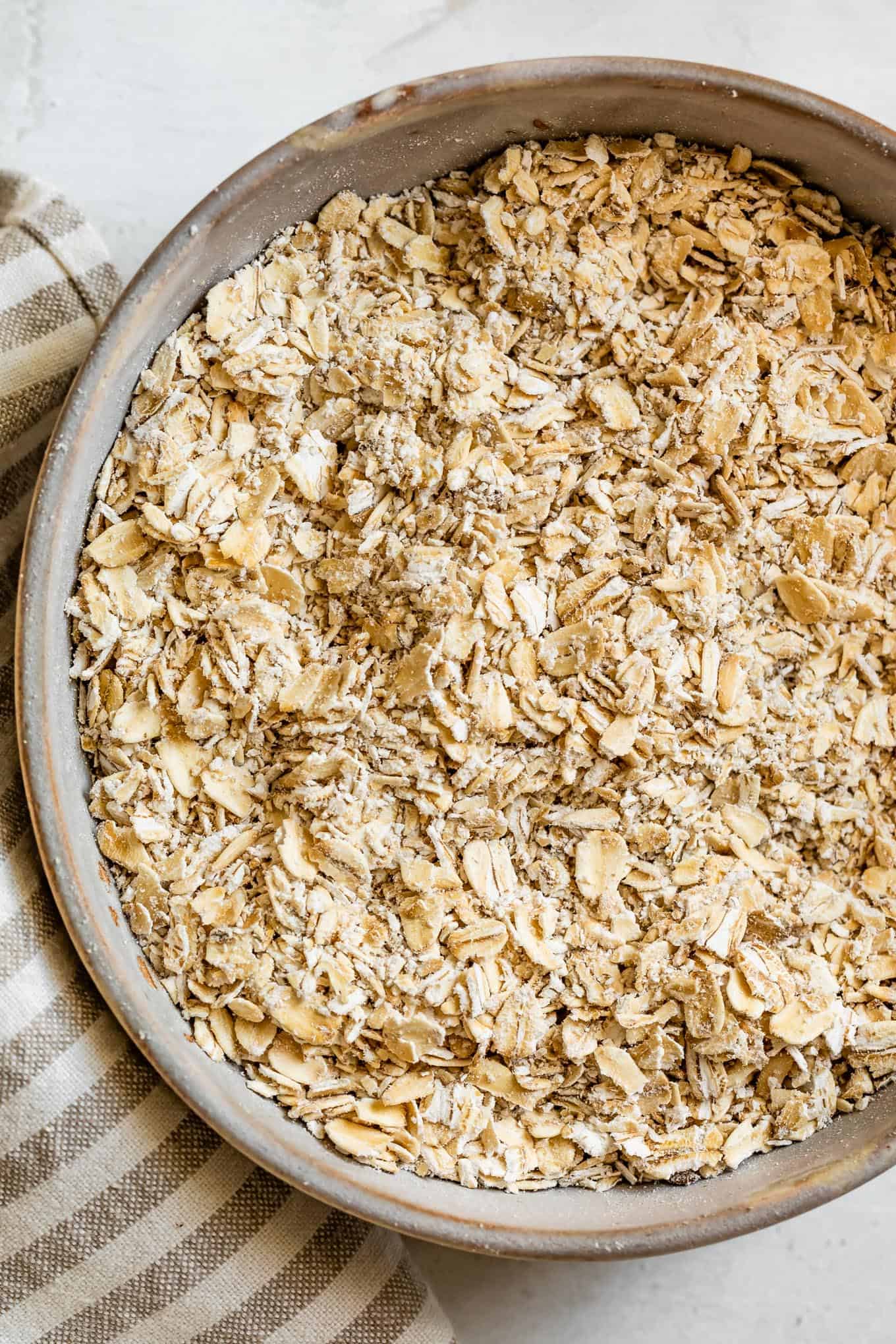



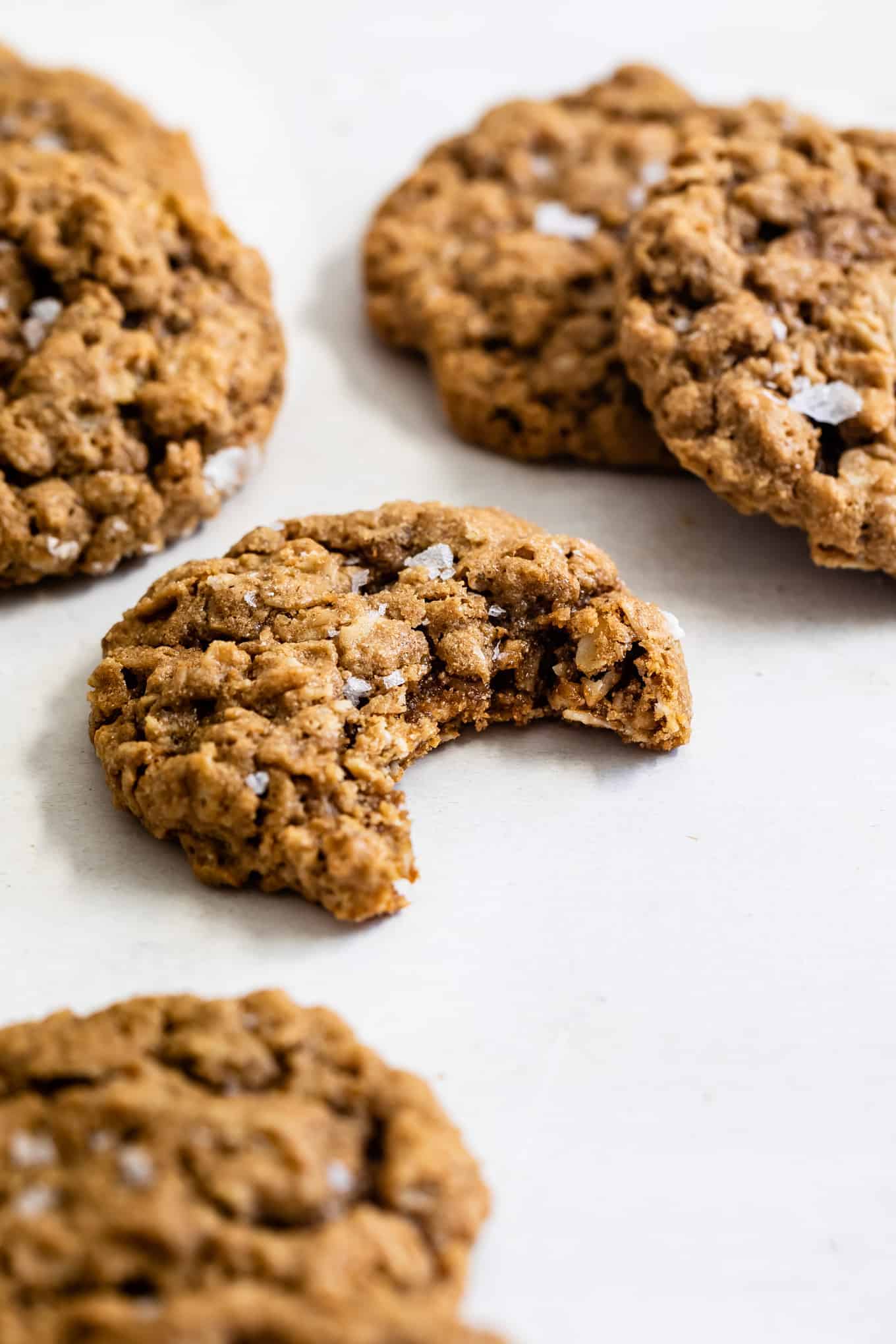



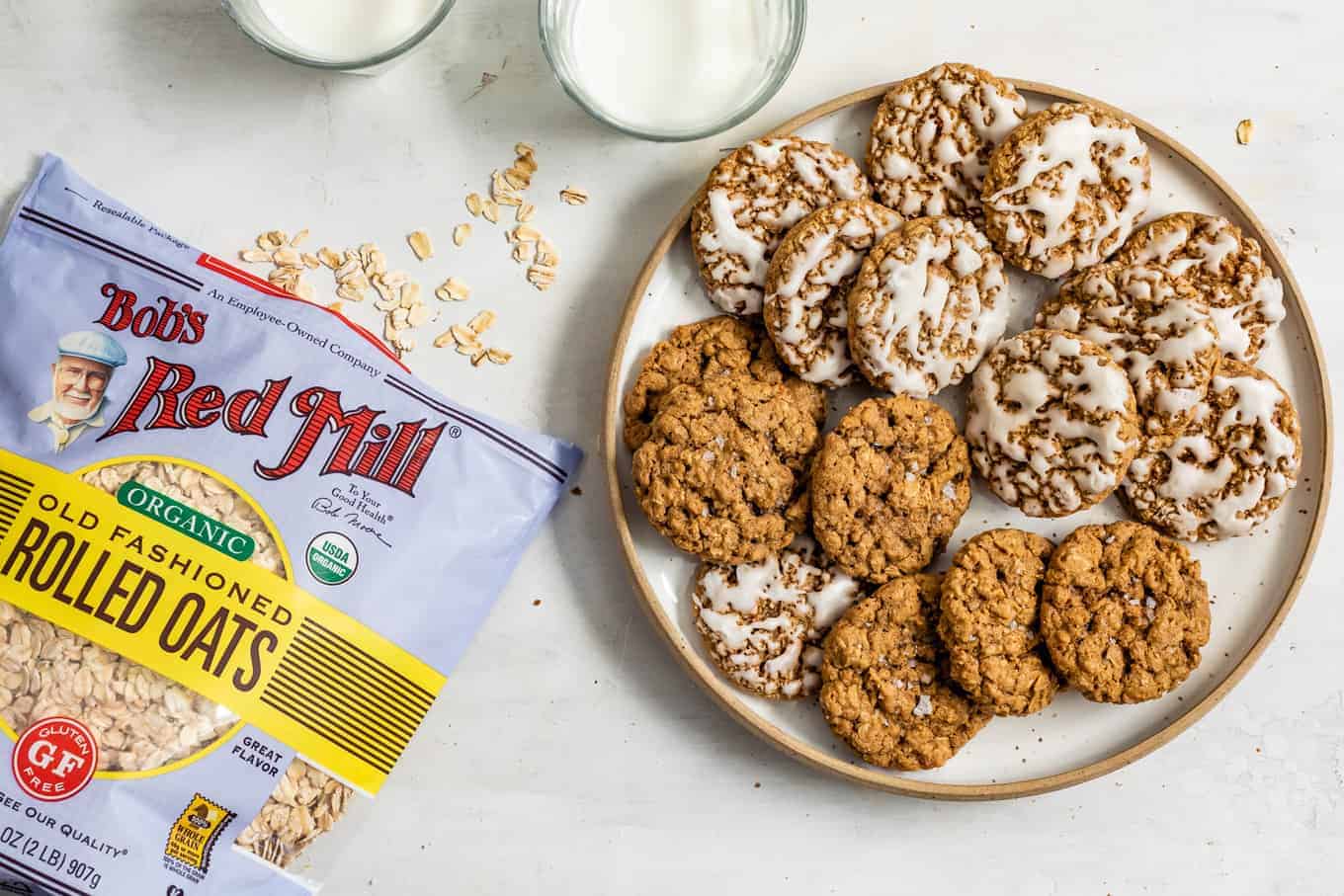

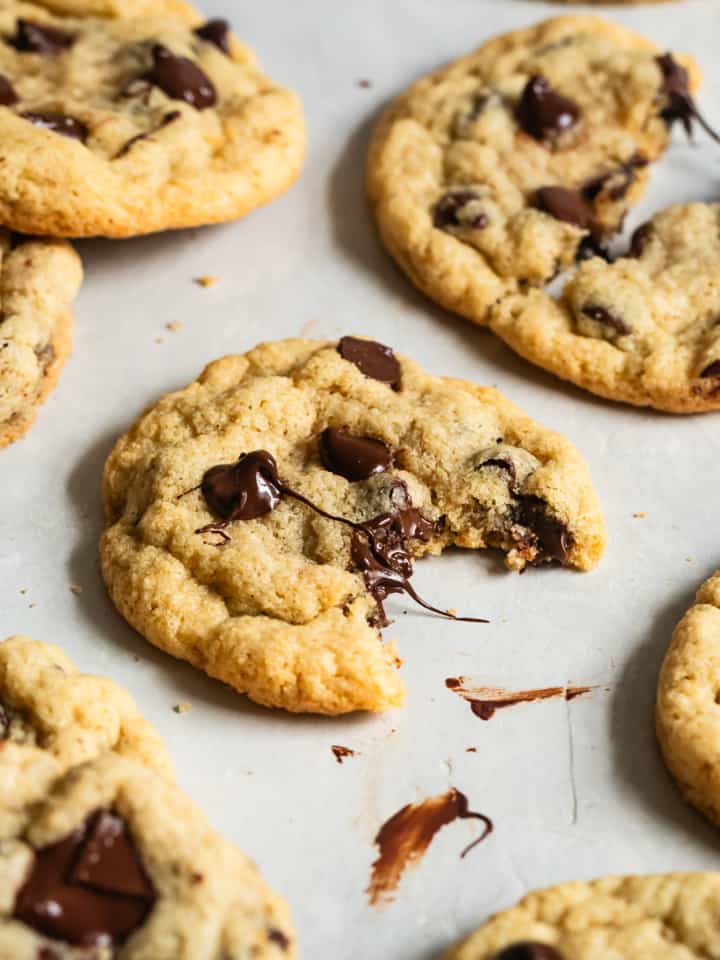

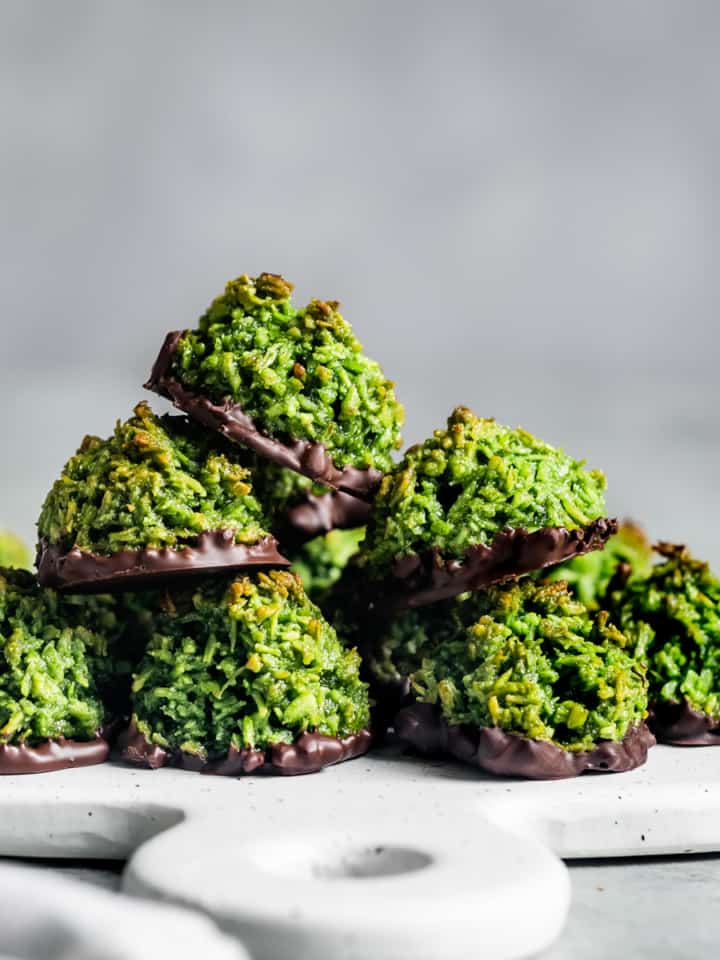



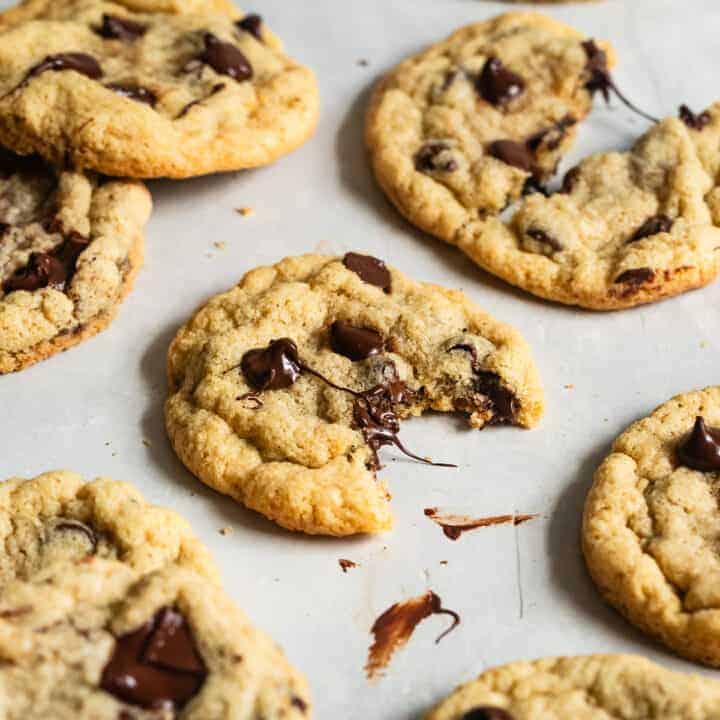

Holly -
Would a flax egg work?
Sarah Menanix -
Hmm - I haven't tested this with a flax egg, but I do have this recipe that's gluten-free and vegan!
Claire -
These are delicious and just what I have been looking for in an oatmeal cookie. I made the version with the oat flour, and still pulsed the oats - just for fun. I did use arrowroot and they turned out fine (of course, I don't know what they are "supposed" to be with the tapioca.)
Mostly I love that they are soft in the middle (when you don't over bake them) and not too sweet at all. The molasses is subtle but gives a little bite.
I split the dough and made half with currants (no raisins) and pecans and the other half with chocolate chips and pecans. Great either way.
Thanks for a wonderful recipe.
DessertForTwo -
These are so delicious!
Tegan -
I just wanted to say I love your recipes. I can always count on them being delicious and not taste gluten free. I have a binder full of your recipes, but would love to purchase a cookbook. Any chance you will be publishing one in the near future?
Sarah Menanix -
This comment made my morning - thank you! I'm struggling to balance just life with two young kids right now, so I don't have any plans for a cookbook in the near future, but if I do, I'll be sure to make sure folks know!
Cj -
This recipe is DELICIOUS!! I made the oat flour version and it was such a hit with everyone! We all felt transported back to our childhood, thank you for sharing this recipe!
Holly -
These are soooo delicious! They taste like an oatmeal cinnamon roll. I know you advised against using quick oats but that's all I had on hand and they turned out ok for me. I couldn't find Bob's Sweet Rice Flour so I went to an Asian store and found glutinous rice flour. Next time, I may try with brown butter. I hope they would turn out ok?
Vanessa -
What else could I sub for the powdered sugar? These look soooooooo delicious and remind me of one of my all-time childhood favorites! I’m also considering doing maple and coconut sugar in the cookies, as sadly I can’t tolerate any refined white sugars…Any thoughts or suggestions? Love your blog!💓
Sarah Menanix -
I think maple syrup in the glaze will work great! You'll just need to reduce the amount of milk. Just drizzle in a little bit, mix, and check the consistency. I also think swapping both sugars for coconut sugar, measured by weight, will work great too!